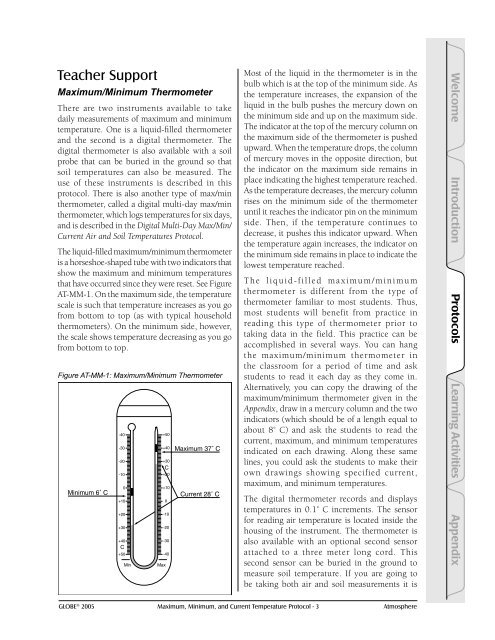Maximum, Minimum, and Current Temperature Protocol - GLOBE
Maximum, Minimum, and Current Temperature Protocol - GLOBE
Maximum, Minimum, and Current Temperature Protocol - GLOBE
You also want an ePaper? Increase the reach of your titles
YUMPU automatically turns print PDFs into web optimized ePapers that Google loves.
Teacher Support<br />
<strong>Maximum</strong>/<strong>Minimum</strong> Thermometer<br />
There are two instruments available to take<br />
daily measurements of maximum <strong>and</strong> minimum<br />
temperature. One is a liquid-filled thermometer<br />
<strong>and</strong> the second is a digital thermometer. The<br />
digital thermometer is also available with a soil<br />
probe that can be buried in the ground so that<br />
soil temperatures can also be measured. The<br />
use of these instruments is described in this<br />
protocol. There is also another type of max/min<br />
thermometer, called a digital multi-day max/min<br />
thermometer, which logs temperatures for six days,<br />
<strong>and</strong> is described in the Digital Multi-Day Max/Min/<br />
<strong>Current</strong> Air <strong>and</strong> Soil <strong>Temperature</strong>s <strong>Protocol</strong>.<br />
The liquid-filled maximum/minimum thermometer<br />
is a horseshoe-shaped tube with two indicators that<br />
show the maximum <strong>and</strong> minimum temperatures<br />
that have occurred since they were reset. See Figure<br />
AT-MM-1. On the maximum side, the temperature<br />
scale is such that temperature increases as you go<br />
from bottom to top (as with typical household<br />
thermometers). On the minimum side, however,<br />
the scale shows temperature decreasing as you go<br />
from bottom to top.<br />
Figure AT-MM-1: <strong>Maximum</strong>/<strong>Minimum</strong> Thermometer<br />
-40<br />
-30<br />
-20<br />
-10<br />
0<br />
<strong>Maximum</strong> 37˚ C<br />
<strong>Minimum</strong> 6˚ C <strong>Current</strong> 28˚ C<br />
+10<br />
+20<br />
+30<br />
+40<br />
C<br />
+50<br />
Min<br />
+50<br />
Max<br />
+40<br />
+30<br />
C<br />
+20<br />
+10<br />
0<br />
-10<br />
-20<br />
-30<br />
-40<br />
Most of the liquid in the thermometer is in the<br />
bulb which is at the top of the minimum side. As<br />
the temperature increases, the expansion of the<br />
liquid in the bulb pushes the mercury down on<br />
the minimum side <strong>and</strong> up on the maximum side.<br />
The indicator at the top of the mercury column on<br />
the maximum side of the thermometer is pushed<br />
upward. When the temperature drops, the column<br />
of mercury moves in the opposite direction, but<br />
the indicator on the maximum side remains in<br />
place indicating the highest temperature reached.<br />
As the temperature decreases, the mercury column<br />
rises on the minimum side of the thermometer<br />
until it reaches the indicator pin on the minimum<br />
side. Then, if the temperature continues to<br />
decrease, it pushes this indicator upward. When<br />
the temperature again increases, the indicator on<br />
the minimum side remains in place to indicate the<br />
lowest temperature reached.<br />
The liquid-filled maximum/minimum<br />
thermometer is different from the type of<br />
thermometer familiar to most students. Thus,<br />
most students will benefit from practice in<br />
reading this type of thermometer prior to<br />
taking data in the field. This practice can be<br />
accomplished in several ways. You can hang<br />
the maximum/minimum thermometer in<br />
the classroom for a period of time <strong>and</strong> ask<br />
students to read it each day as they come in.<br />
Alternatively, you can copy the drawing of the<br />
maximum/minimum thermometer given in the<br />
Appendix, draw in a mercury column <strong>and</strong> the two<br />
indicators (which should be of a length equal to<br />
about 8˚ C) <strong>and</strong> ask the students to read the<br />
current, maximum, <strong>and</strong> minimum temperatures<br />
indicated on each drawing. Along these same<br />
lines, you could ask the students to make their<br />
own drawings showing specified current,<br />
maximum, <strong>and</strong> minimum temperatures.<br />
The digital thermometer records <strong>and</strong> displays<br />
temperatures in 0.1˚ C increments. The sensor<br />
for reading air temperature is located inside the<br />
housing of the instrument. The thermometer is<br />
also available with an optional second sensor<br />
attached to a three meter long cord. This<br />
second sensor can be buried in the ground to<br />
measure soil temperature. If you are going to<br />
be taking both air <strong>and</strong> soil measurements it is<br />
<strong>GLOBE</strong> ® 2005 <strong>Maximum</strong>, <strong>Minimum</strong>, <strong>and</strong> <strong>Current</strong> <strong>Temperature</strong> <strong>Protocol</strong> - 3 Atmosphere<br />
Welcome Introduction <strong>Protocol</strong>s<br />
Learning Activities Appendix
















